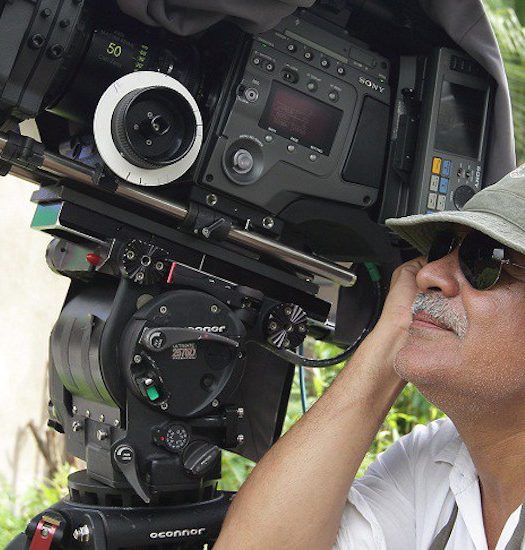Te3n – Decoding the thriller with Ribhu and Sujoy
Looking tired and sleepy from shooting, editing and promoting continuously for almost a month, Ribhu Dasgupta and Sujoy Ghosh join Pandolin with surprising energy to discuss the form and craft of filmmaking. While Ribhu has to his credit a psychological thriller like Michael and the Amitabh Bachchan starrer TV show Yudh, Sujoy has given the industry a riveting thriller like Kahaani and more recently the short film Ahalya. The director-producer duo who have now joined hands for the upcoming thriller Te3n, talk about the pleasures and challenges involved in the making of the film and the age-old relationship with filming in Kolkata.

Sujoy Ghosh and Ribhu Dasgupta at the trailer launch of Te3n
How did the idea of Te3n come about? And what led to this unique way of naming the film?
Ribhu: You must ask Sujoy that. He is the one who came up with this idea (smiles)
Sujoy: It’s named like that so that people can understand ‘Te3n’ as in ‘three’ as opposed to the word ‘teen.’ Also, Satayajit Ray had said something really interesting. “Art is not art until it evokes any kind of reaction.” And as long as people are reacting to the title, I am happy.
Ribhu, after Michael or even Yudh for that matter, Te3n is the third story that revolves around an aged man trying to hold his life and family together through a major crisis. Is this a subject that continues to intrigue you?
With this film we were essentially aiming at working with Mr. Bachchan. That kind of led us to choose this world and this story. I might just go ahead and do something completely different tomorrow. All that matters is that what one feels like writing or dwelling into at this very moment. That is what decides the path ahead.
When you have a story, which you have thought of right from the inception stage, you sort of start living that story
What kind of preparation did you go through while working with actors of such a great scale?
Ribhu: When you have a story, which you have thought of right from the inception stage, you sort of start living that story. Including minute details like the kind of shoes your character will wear to how they will say the dialogues. So you are quite well versed with what do you want from the actors, the technicians and in general from the people around you. Apart from that you just have to push yourself to give your best when you come to set each day.
READ: I AM NOT A SUPERSTAR – AMITABH BACHCHAN
This is the first Hindi film where the iconic Victorian-era Writers’ Buildings have been used for shooting. Does that have to do with any artistic requirements of the film?
Ribhu: Honestly, there was nothing that we were trying to push through this. Most of the film is shot in real locations and he (Sujoy) had already shot Kahaani there. That left me with very few locations that were not already used. Hence when we went for the recce, we thought this location would add visually to the film. And not just because it was a virgin location, structurally also the building is quite fascinating.
And it’s very fortunate that we got to shoot at the Writers’ building and it is indeed the first time something like this has happened. It is very kind that the government of Bengal let us shoot there.
If Nawaz, Amitabh Sir and Vidya are the three pillars of the film, Kolkata is the fourth pillar
How central is the location to the film?
Ribhu: It is very, very important. If Nawaz (Nawazuddin Siddiqui), Amitabh (Bachchan) Sir and Vidya (Balan) are the three pillars of the film, Kolkata is the fourth pillar. It is almost a fourth character.

Amitabh Bachchan in a still from Te3n
What were the challenges faced by you during the course of the film?
Ribhu: Whenever you go to Kolkata with Mr. Amitabh Bachchan, it’s a challenge. He has his biggest fan base in Kolkata. We had close to 700-800 cops at every destination because there were at least eight to ten thousand fans who would turn up to see him every day. They were people who understood art though. So it never happened that we had to cancel a shoot because of the crowd. The people were quite cooperative, but still managing a crowd like that was quite a task. More so because they were hard-core AB fans.
It is very important to realize that a director can only be as good as his team
Sujoy, do you think that production plays an equally important role in the storytelling as does direction?
Yes, Absolutely. The producer plays a very important role. If you look at things objectively, what is the role of a producer? To get the best possible technicians, the best music, the best editor, the best cinematographer, within the realms of his budget. So if he does not do his job properly, there is going to be a compromise in the way the story unfolds. It is very important to realize that a director can only be as good as his team. In fact, we all are only as strong as our teams. So production does play a vital role, but more so in an administrative way as opposed to creative.
READ: THE OBJECTIVE WAS TO MAKE A FILM THAT WILL ENTERTAIN MY AUDIENCE – SUJOY GHOSH
Being a filmmaker and a producer, why do you think is there a dearth of thrillers in our industry? Is it difficult to get funding for these films even now?
Sujoy: Actually there is a misconception that thrillers don’t have a repeat value. Once the end is known, most producers feel that the audience will not see the film. I disagree to that. I feel the most important part of a film is the journey the characters go through. The climax is hardly a 15-20 minute part of the film. But the journey a character goes through is what the audience actually relates with.
There is a misconception that thrillers don’t have a repeat value
Ribhu, how different is shooting a film from a TV series?
According to me, be it a film, a TV series or an ad film, it is important to understand that as long as your content is good, you will draw in audiences. So you have to work equally hard for all of them. The better prepared you are, the better it is for the job you are doing.
READ: HAVE 24 AND YUDH MADE WAY FOR BETTER TELEVISION ENTERTAINMENT?
You’ll adopted a unique marketing strategy for this film wherein you’ll invited the audience to share their poster designs. How has that shaped up?
Ribhu: That has worked out quite well actually. People have given us a lot of contribution. We are still having a look at the inputs and posters sent by the participants. Once we shortlist these, we will release these posters in their respective cities. For example, if you’re from Hyderabad and you’ve sent in an entry which we like, we are going to call you and gratify you and then release your poster in Hyderabad. We’ve got some really interesting entries so far.



